Analysis of Credit, Lending Decisions, and Regulatory Compliance
VerifiedAdded on 2020/05/04
|7
|1370
|80
AI Summary
The assignment titled 'Credit and Lending Decision: Analyzing Securities Regulations' presents a detailed exploration of various legal facets surrounding credit and lending decisions in finance. Key sections such as 708a discuss applicable securities regulations including exemptions under specific conditions. The document outlines how these exemptions cater to different scenarios like small business due diligence, corporate social responsibility, initial public offerings (IPOs), insider trading restrictions, and cross-border acquisition completions. Insight is provided on the role of a merchant banker in takeovers and the mandatory timeline for public announcements post-acquisition. By dissecting laws across jurisdictions such as Australia, EU, and China, the assignment offers comprehensive coverage on maintaining investor protection while navigating legal frameworks pertinent to financial transactions.
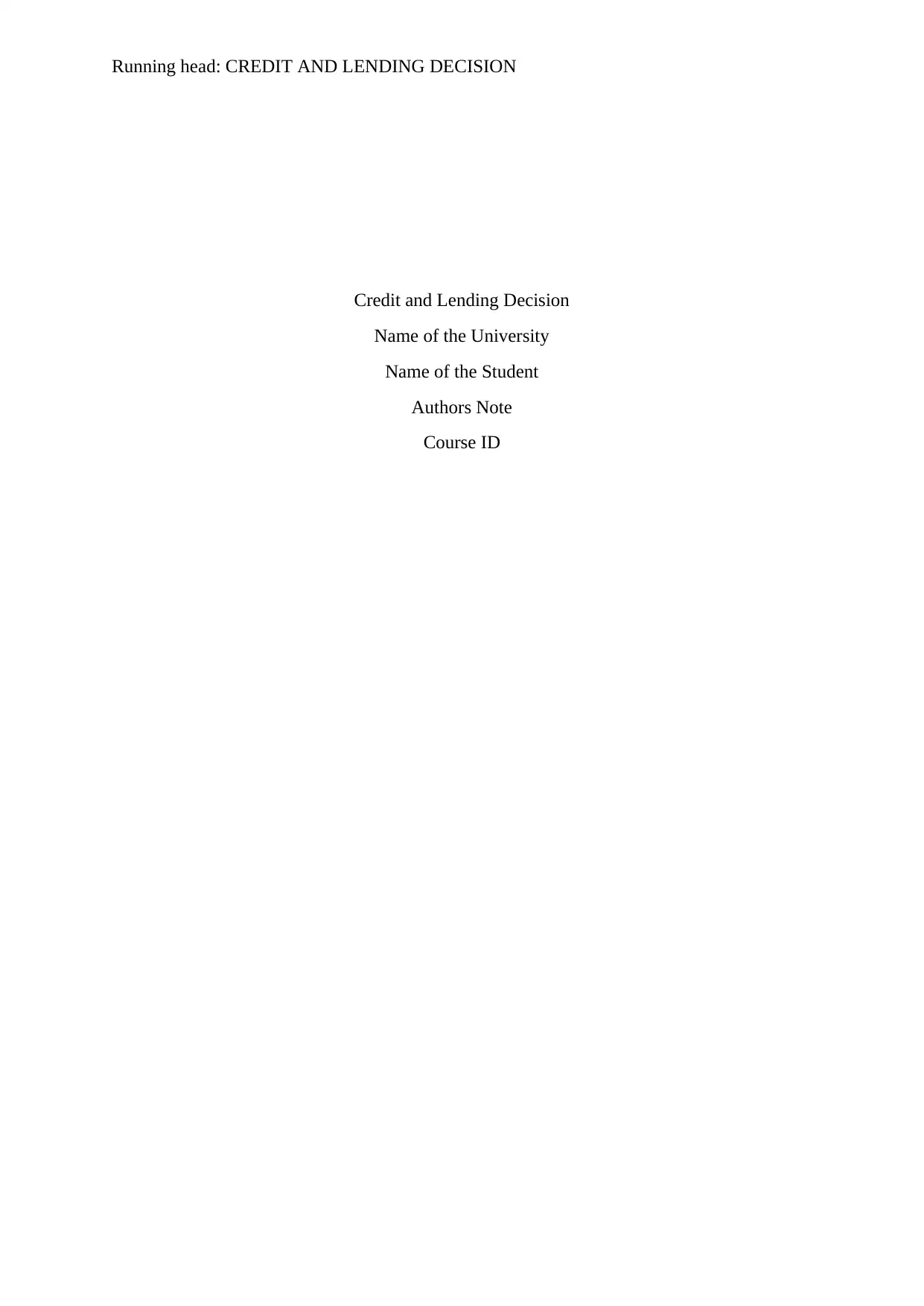
Running head: CREDIT AND LENDING DECISION
Credit and Lending Decision
Name of the University
Name of the Student
Authors Note
Course ID
Credit and Lending Decision
Name of the University
Name of the Student
Authors Note
Course ID
Paraphrase This Document
Need a fresh take? Get an instant paraphrase of this document with our AI Paraphraser
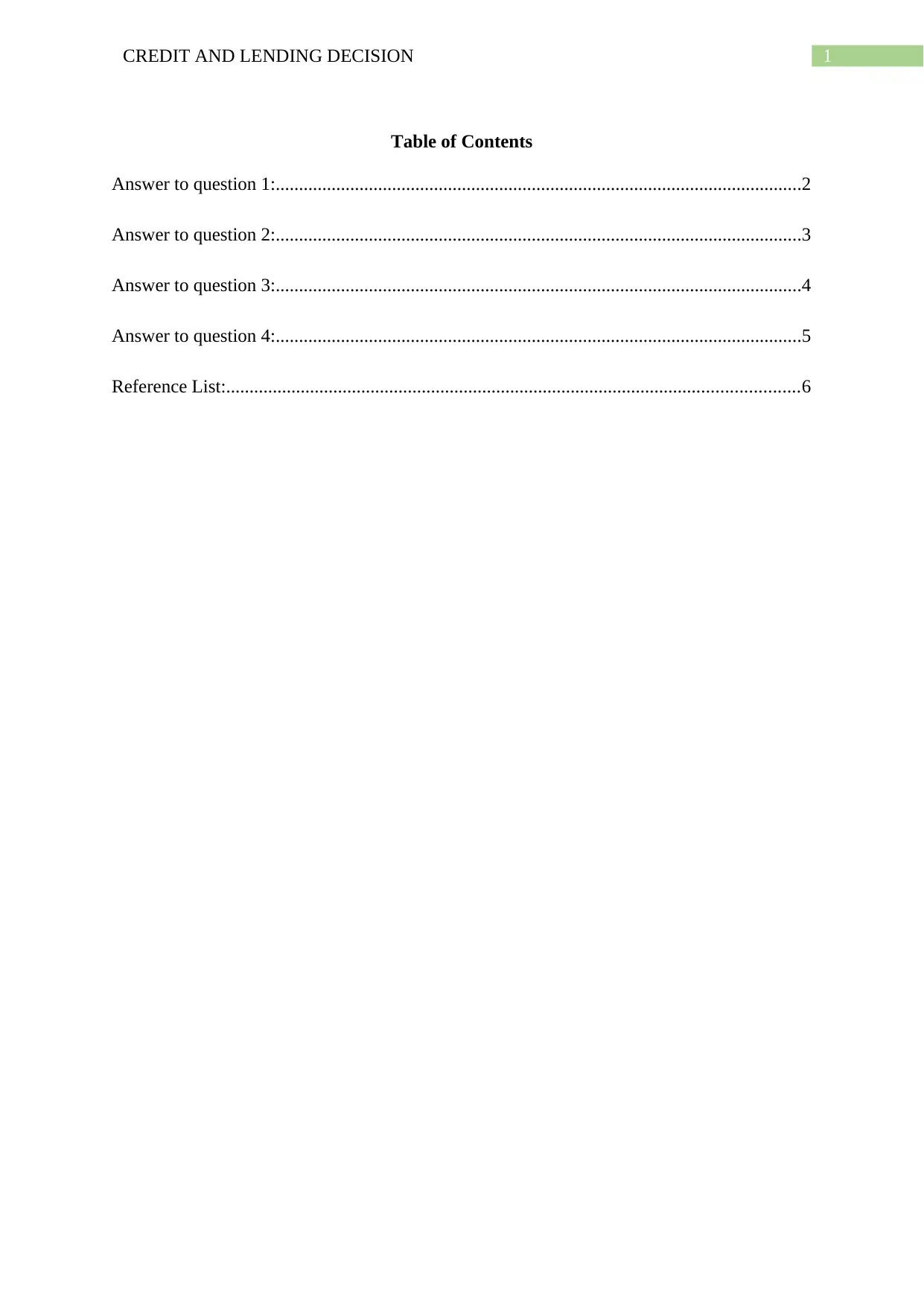
1CREDIT AND LENDING DECISION
Table of Contents
Answer to question 1:.................................................................................................................2
Answer to question 2:.................................................................................................................3
Answer to question 3:.................................................................................................................4
Answer to question 4:.................................................................................................................5
Reference List:...........................................................................................................................6
Table of Contents
Answer to question 1:.................................................................................................................2
Answer to question 2:.................................................................................................................3
Answer to question 3:.................................................................................................................4
Answer to question 4:.................................................................................................................5
Reference List:...........................................................................................................................6
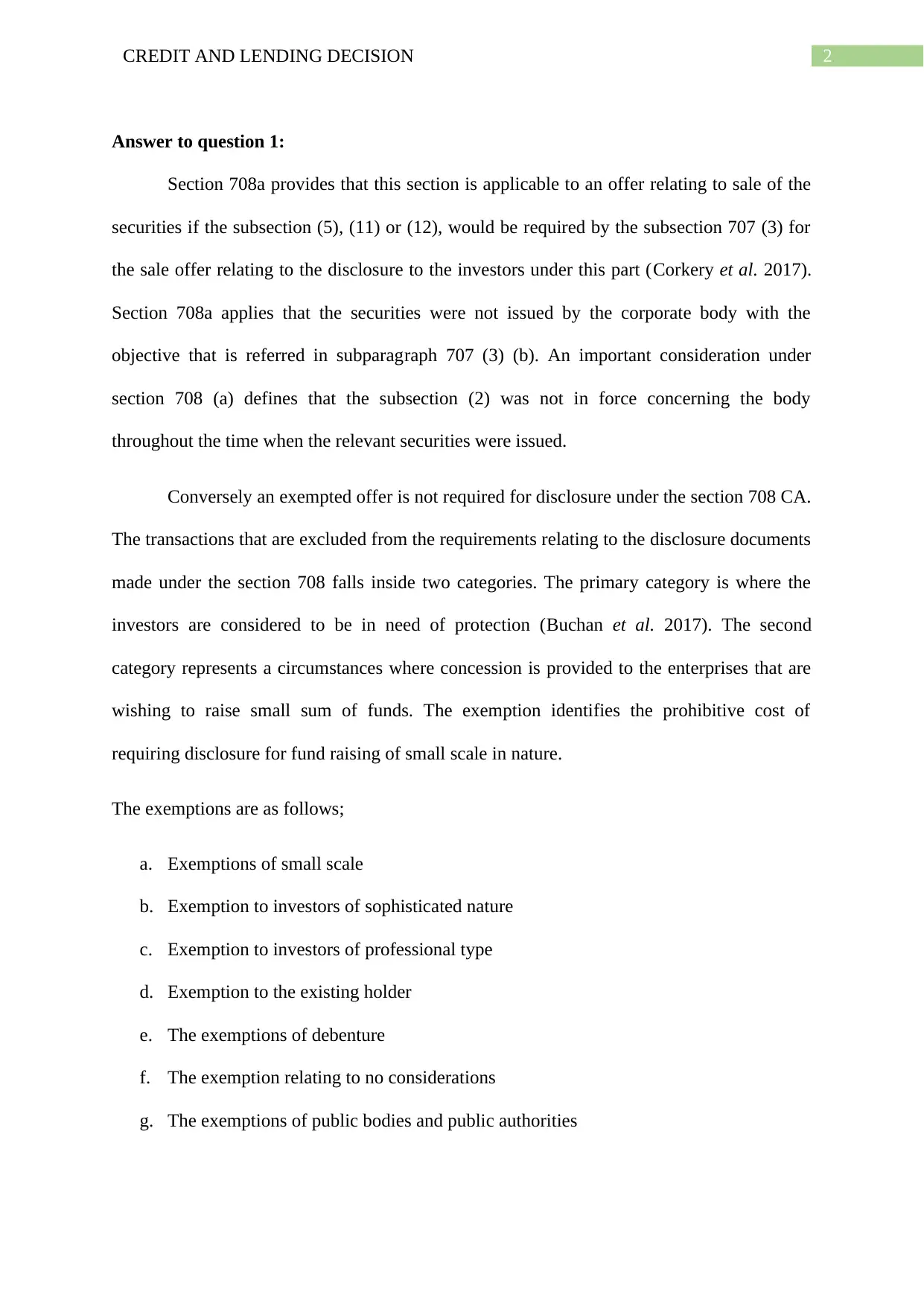
2CREDIT AND LENDING DECISION
Answer to question 1:
Section 708a provides that this section is applicable to an offer relating to sale of the
securities if the subsection (5), (11) or (12), would be required by the subsection 707 (3) for
the sale offer relating to the disclosure to the investors under this part (Corkery et al. 2017).
Section 708a applies that the securities were not issued by the corporate body with the
objective that is referred in subparagraph 707 (3) (b). An important consideration under
section 708 (a) defines that the subsection (2) was not in force concerning the body
throughout the time when the relevant securities were issued.
Conversely an exempted offer is not required for disclosure under the section 708 CA.
The transactions that are excluded from the requirements relating to the disclosure documents
made under the section 708 falls inside two categories. The primary category is where the
investors are considered to be in need of protection (Buchan et al. 2017). The second
category represents a circumstances where concession is provided to the enterprises that are
wishing to raise small sum of funds. The exemption identifies the prohibitive cost of
requiring disclosure for fund raising of small scale in nature.
The exemptions are as follows;
a. Exemptions of small scale
b. Exemption to investors of sophisticated nature
c. Exemption to investors of professional type
d. Exemption to the existing holder
e. The exemptions of debenture
f. The exemption relating to no considerations
g. The exemptions of public bodies and public authorities
Answer to question 1:
Section 708a provides that this section is applicable to an offer relating to sale of the
securities if the subsection (5), (11) or (12), would be required by the subsection 707 (3) for
the sale offer relating to the disclosure to the investors under this part (Corkery et al. 2017).
Section 708a applies that the securities were not issued by the corporate body with the
objective that is referred in subparagraph 707 (3) (b). An important consideration under
section 708 (a) defines that the subsection (2) was not in force concerning the body
throughout the time when the relevant securities were issued.
Conversely an exempted offer is not required for disclosure under the section 708 CA.
The transactions that are excluded from the requirements relating to the disclosure documents
made under the section 708 falls inside two categories. The primary category is where the
investors are considered to be in need of protection (Buchan et al. 2017). The second
category represents a circumstances where concession is provided to the enterprises that are
wishing to raise small sum of funds. The exemption identifies the prohibitive cost of
requiring disclosure for fund raising of small scale in nature.
The exemptions are as follows;
a. Exemptions of small scale
b. Exemption to investors of sophisticated nature
c. Exemption to investors of professional type
d. Exemption to the existing holder
e. The exemptions of debenture
f. The exemption relating to no considerations
g. The exemptions of public bodies and public authorities
⊘ This is a preview!⊘
Do you want full access?
Subscribe today to unlock all pages.

Trusted by 1+ million students worldwide
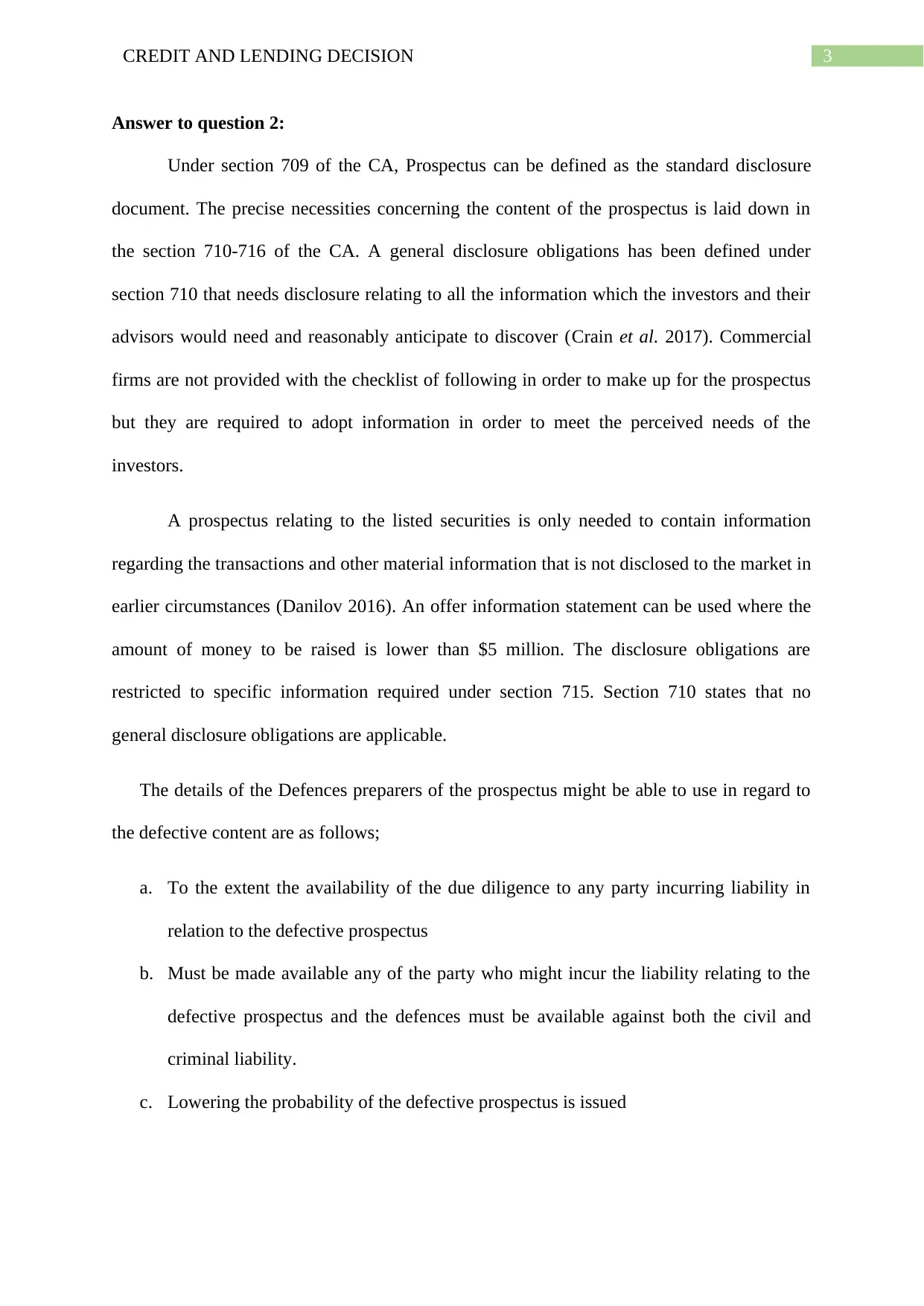
3CREDIT AND LENDING DECISION
Answer to question 2:
Under section 709 of the CA, Prospectus can be defined as the standard disclosure
document. The precise necessities concerning the content of the prospectus is laid down in
the section 710-716 of the CA. A general disclosure obligations has been defined under
section 710 that needs disclosure relating to all the information which the investors and their
advisors would need and reasonably anticipate to discover (Crain et al. 2017). Commercial
firms are not provided with the checklist of following in order to make up for the prospectus
but they are required to adopt information in order to meet the perceived needs of the
investors.
A prospectus relating to the listed securities is only needed to contain information
regarding the transactions and other material information that is not disclosed to the market in
earlier circumstances (Danilov 2016). An offer information statement can be used where the
amount of money to be raised is lower than $5 million. The disclosure obligations are
restricted to specific information required under section 715. Section 710 states that no
general disclosure obligations are applicable.
The details of the Defences preparers of the prospectus might be able to use in regard to
the defective content are as follows;
a. To the extent the availability of the due diligence to any party incurring liability in
relation to the defective prospectus
b. Must be made available any of the party who might incur the liability relating to the
defective prospectus and the defences must be available against both the civil and
criminal liability.
c. Lowering the probability of the defective prospectus is issued
Answer to question 2:
Under section 709 of the CA, Prospectus can be defined as the standard disclosure
document. The precise necessities concerning the content of the prospectus is laid down in
the section 710-716 of the CA. A general disclosure obligations has been defined under
section 710 that needs disclosure relating to all the information which the investors and their
advisors would need and reasonably anticipate to discover (Crain et al. 2017). Commercial
firms are not provided with the checklist of following in order to make up for the prospectus
but they are required to adopt information in order to meet the perceived needs of the
investors.
A prospectus relating to the listed securities is only needed to contain information
regarding the transactions and other material information that is not disclosed to the market in
earlier circumstances (Danilov 2016). An offer information statement can be used where the
amount of money to be raised is lower than $5 million. The disclosure obligations are
restricted to specific information required under section 715. Section 710 states that no
general disclosure obligations are applicable.
The details of the Defences preparers of the prospectus might be able to use in regard to
the defective content are as follows;
a. To the extent the availability of the due diligence to any party incurring liability in
relation to the defective prospectus
b. Must be made available any of the party who might incur the liability relating to the
defective prospectus and the defences must be available against both the civil and
criminal liability.
c. Lowering the probability of the defective prospectus is issued
Paraphrase This Document
Need a fresh take? Get an instant paraphrase of this document with our AI Paraphraser
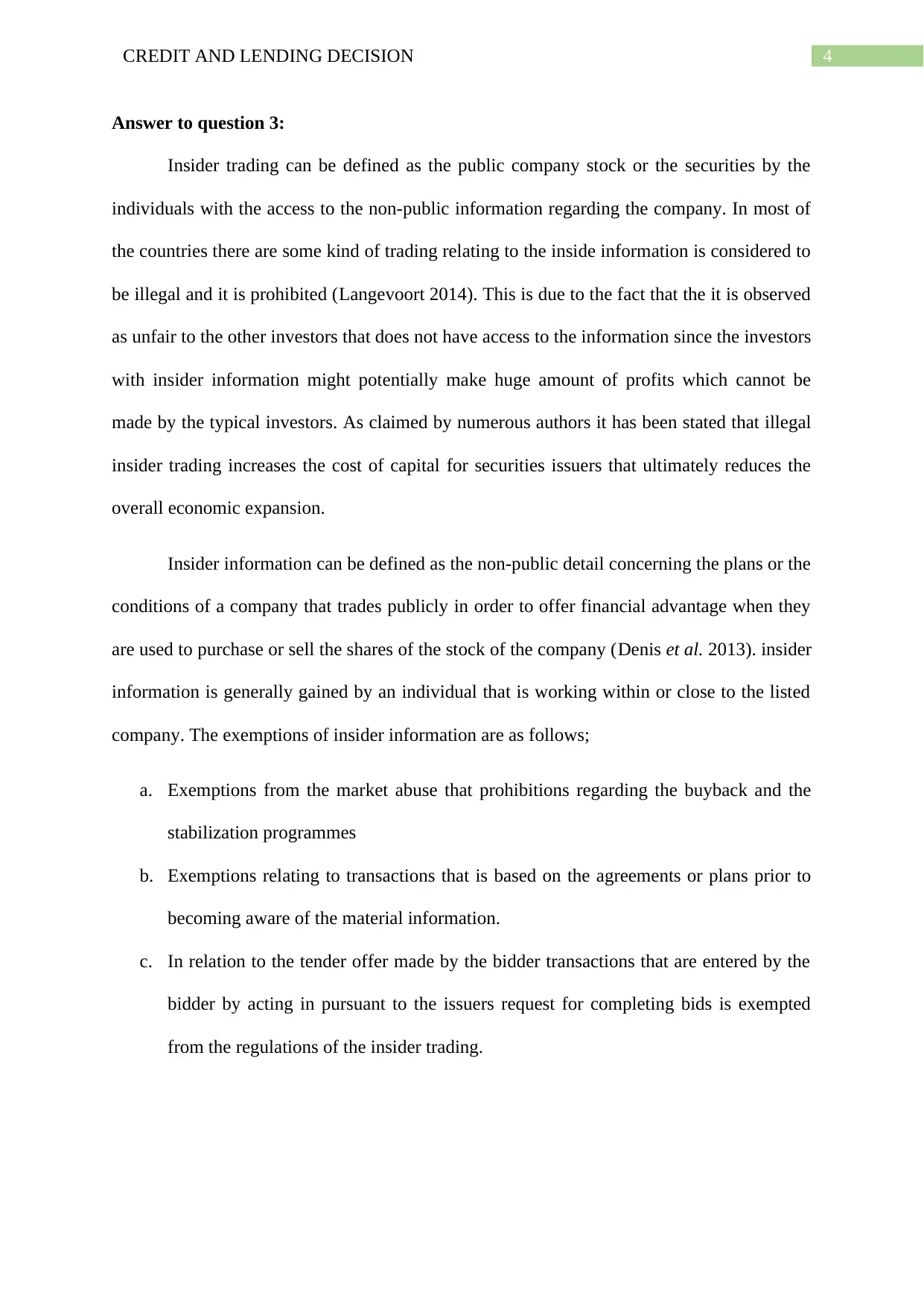
4CREDIT AND LENDING DECISION
Answer to question 3:
Insider trading can be defined as the public company stock or the securities by the
individuals with the access to the non-public information regarding the company. In most of
the countries there are some kind of trading relating to the inside information is considered to
be illegal and it is prohibited (Langevoort 2014). This is due to the fact that the it is observed
as unfair to the other investors that does not have access to the information since the investors
with insider information might potentially make huge amount of profits which cannot be
made by the typical investors. As claimed by numerous authors it has been stated that illegal
insider trading increases the cost of capital for securities issuers that ultimately reduces the
overall economic expansion.
Insider information can be defined as the non-public detail concerning the plans or the
conditions of a company that trades publicly in order to offer financial advantage when they
are used to purchase or sell the shares of the stock of the company (Denis et al. 2013). insider
information is generally gained by an individual that is working within or close to the listed
company. The exemptions of insider information are as follows;
a. Exemptions from the market abuse that prohibitions regarding the buyback and the
stabilization programmes
b. Exemptions relating to transactions that is based on the agreements or plans prior to
becoming aware of the material information.
c. In relation to the tender offer made by the bidder transactions that are entered by the
bidder by acting in pursuant to the issuers request for completing bids is exempted
from the regulations of the insider trading.
Answer to question 3:
Insider trading can be defined as the public company stock or the securities by the
individuals with the access to the non-public information regarding the company. In most of
the countries there are some kind of trading relating to the inside information is considered to
be illegal and it is prohibited (Langevoort 2014). This is due to the fact that the it is observed
as unfair to the other investors that does not have access to the information since the investors
with insider information might potentially make huge amount of profits which cannot be
made by the typical investors. As claimed by numerous authors it has been stated that illegal
insider trading increases the cost of capital for securities issuers that ultimately reduces the
overall economic expansion.
Insider information can be defined as the non-public detail concerning the plans or the
conditions of a company that trades publicly in order to offer financial advantage when they
are used to purchase or sell the shares of the stock of the company (Denis et al. 2013). insider
information is generally gained by an individual that is working within or close to the listed
company. The exemptions of insider information are as follows;
a. Exemptions from the market abuse that prohibitions regarding the buyback and the
stabilization programmes
b. Exemptions relating to transactions that is based on the agreements or plans prior to
becoming aware of the material information.
c. In relation to the tender offer made by the bidder transactions that are entered by the
bidder by acting in pursuant to the issuers request for completing bids is exempted
from the regulations of the insider trading.

5CREDIT AND LENDING DECISION
Answer to question 4:
Takeover can be defined as the procedure where an acquirer takes over the control of
the management of a targeted organization that acquires a substantial quantity of shares or the
rights of voting of such company.
Prior to making any public announcement of the offer the acquirer is under
obligations of appointing the merchant banker holding the certificate of the registration that is
granted by the board that is not the associate of the group of the acquirer or the target firm
(Peng et al. 2016). The documents that are involved in the takeover procedure are as follows;
a. Memorandum of understanding
b. Balance sheet as per the cut-off date
c. Certificate of no objection in respect of the articles of association
d. Board meeting minutes
e. Transfer forms
f. Final agreement
Concerning the timing of the acquisition the acquirer is required to make public
announcement of the acquisition within the four working days in an agreement to acquire the
shares, voting rights of the target company after any form of changes that would lead to the
change in the control of the targeted company (Lim et al. 2016).
Answer to question 4:
Takeover can be defined as the procedure where an acquirer takes over the control of
the management of a targeted organization that acquires a substantial quantity of shares or the
rights of voting of such company.
Prior to making any public announcement of the offer the acquirer is under
obligations of appointing the merchant banker holding the certificate of the registration that is
granted by the board that is not the associate of the group of the acquirer or the target firm
(Peng et al. 2016). The documents that are involved in the takeover procedure are as follows;
a. Memorandum of understanding
b. Balance sheet as per the cut-off date
c. Certificate of no objection in respect of the articles of association
d. Board meeting minutes
e. Transfer forms
f. Final agreement
Concerning the timing of the acquisition the acquirer is required to make public
announcement of the acquisition within the four working days in an agreement to acquire the
shares, voting rights of the target company after any form of changes that would lead to the
change in the control of the targeted company (Lim et al. 2016).
⊘ This is a preview!⊘
Do you want full access?
Subscribe today to unlock all pages.

Trusted by 1+ million students worldwide
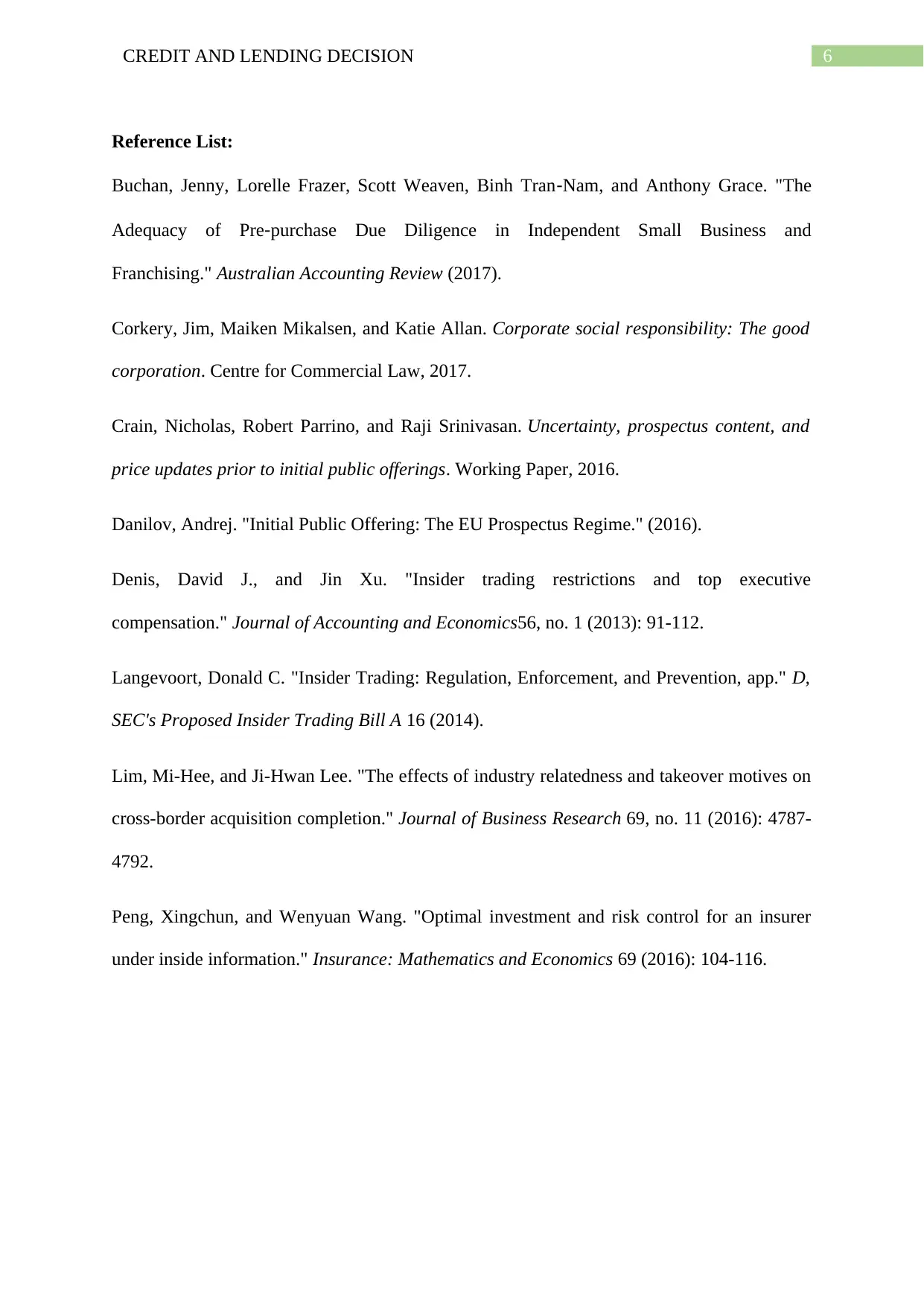
6CREDIT AND LENDING DECISION
Reference List:
Buchan, Jenny, Lorelle Frazer, Scott Weaven, Binh Tran‐Nam, and Anthony Grace. "The
Adequacy of Pre‐purchase Due Diligence in Independent Small Business and
Franchising." Australian Accounting Review (2017).
Corkery, Jim, Maiken Mikalsen, and Katie Allan. Corporate social responsibility: The good
corporation. Centre for Commercial Law, 2017.
Crain, Nicholas, Robert Parrino, and Raji Srinivasan. Uncertainty, prospectus content, and
price updates prior to initial public offerings. Working Paper, 2016.
Danilov, Andrej. "Initial Public Offering: The EU Prospectus Regime." (2016).
Denis, David J., and Jin Xu. "Insider trading restrictions and top executive
compensation." Journal of Accounting and Economics56, no. 1 (2013): 91-112.
Langevoort, Donald C. "Insider Trading: Regulation, Enforcement, and Prevention, app." D,
SEC's Proposed Insider Trading Bill A 16 (2014).
Lim, Mi-Hee, and Ji-Hwan Lee. "The effects of industry relatedness and takeover motives on
cross-border acquisition completion." Journal of Business Research 69, no. 11 (2016): 4787-
4792.
Peng, Xingchun, and Wenyuan Wang. "Optimal investment and risk control for an insurer
under inside information." Insurance: Mathematics and Economics 69 (2016): 104-116.
Reference List:
Buchan, Jenny, Lorelle Frazer, Scott Weaven, Binh Tran‐Nam, and Anthony Grace. "The
Adequacy of Pre‐purchase Due Diligence in Independent Small Business and
Franchising." Australian Accounting Review (2017).
Corkery, Jim, Maiken Mikalsen, and Katie Allan. Corporate social responsibility: The good
corporation. Centre for Commercial Law, 2017.
Crain, Nicholas, Robert Parrino, and Raji Srinivasan. Uncertainty, prospectus content, and
price updates prior to initial public offerings. Working Paper, 2016.
Danilov, Andrej. "Initial Public Offering: The EU Prospectus Regime." (2016).
Denis, David J., and Jin Xu. "Insider trading restrictions and top executive
compensation." Journal of Accounting and Economics56, no. 1 (2013): 91-112.
Langevoort, Donald C. "Insider Trading: Regulation, Enforcement, and Prevention, app." D,
SEC's Proposed Insider Trading Bill A 16 (2014).
Lim, Mi-Hee, and Ji-Hwan Lee. "The effects of industry relatedness and takeover motives on
cross-border acquisition completion." Journal of Business Research 69, no. 11 (2016): 4787-
4792.
Peng, Xingchun, and Wenyuan Wang. "Optimal investment and risk control for an insurer
under inside information." Insurance: Mathematics and Economics 69 (2016): 104-116.
1 out of 7
Related Documents
Your All-in-One AI-Powered Toolkit for Academic Success.
+13062052269
info@desklib.com
Available 24*7 on WhatsApp / Email
![[object Object]](/_next/static/media/star-bottom.7253800d.svg)
Unlock your academic potential
Copyright © 2020–2025 A2Z Services. All Rights Reserved. Developed and managed by ZUCOL.





